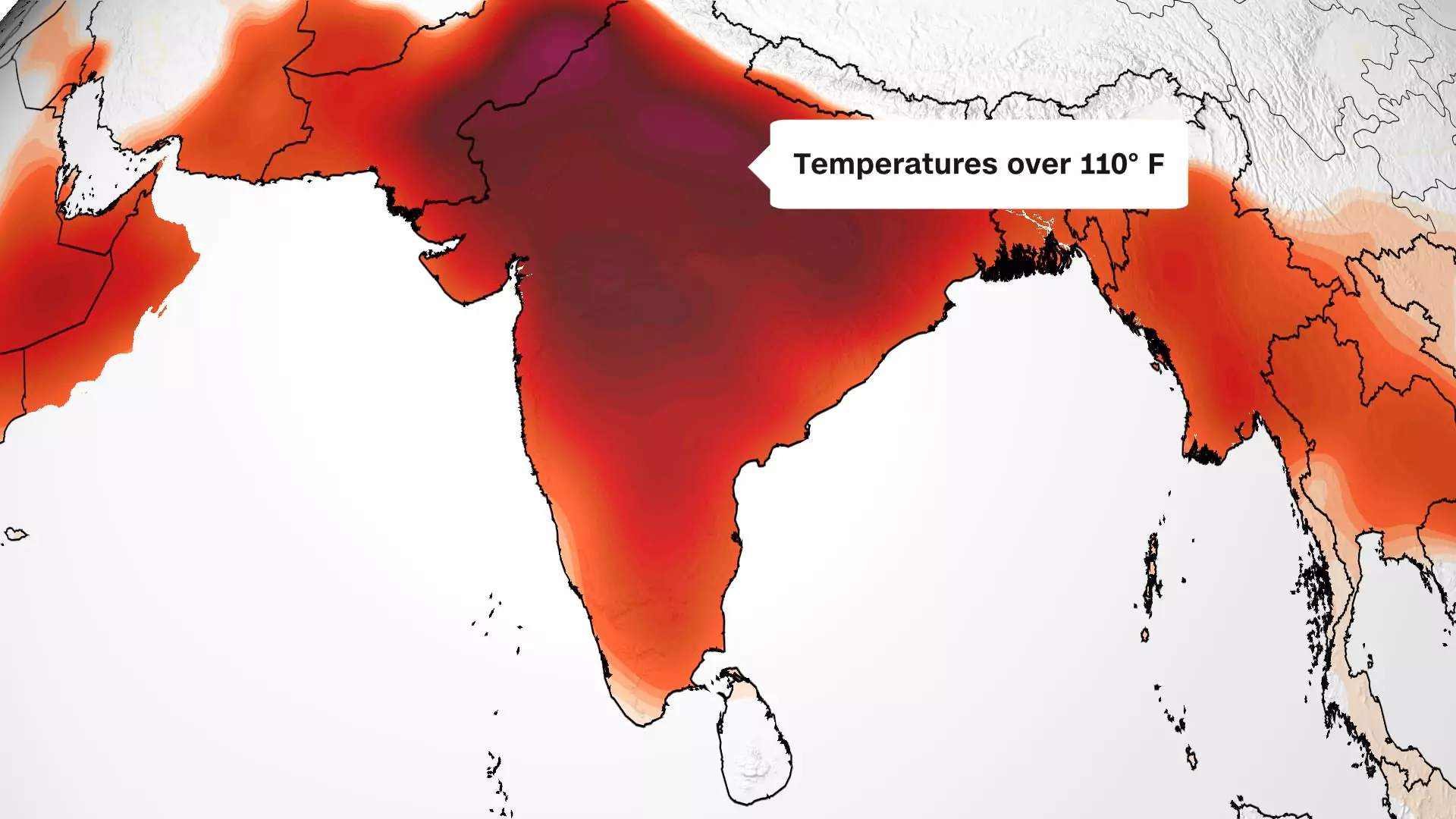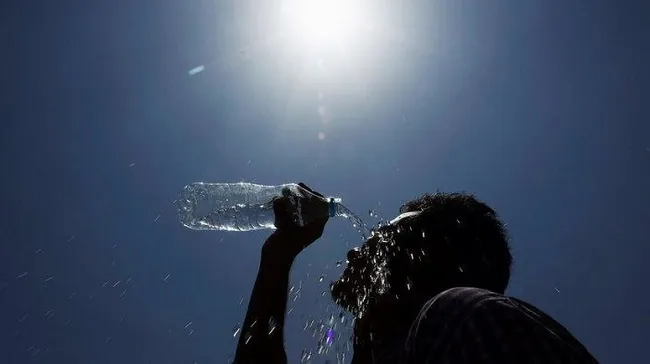Heat Dome Effect, Extreme Heat Events in India
India is experiencing a dramatic surge in extreme heat events, exacerbated by a combination of climate change, urban heat islands (UHIs), and the Heat Dome Effect.
- Heat Dome Effect: A phenomenon where high-pressure systems trap hot air, leading to prolonged and unprecedented heatwaves.
- Urban Heat Island (UHI) Effect: Urban areas experience significantly higher temperatures due to dense infrastructure, lack of vegetation, and heat-absorbing materials.
- Climate Change: Rising global temperatures are intensifying and extending heatwaves beyond historical patterns.
2024 and 2025 Heatwave Forecast for India
- Studies predict record-breaking temperatures in Indian
cities in
May and June 2024, with peak temperatures possibly
exceeding
50°C (122°F) in some areas.
- Extreme heat events will become more frequent,
prolonged,
and widespread, affecting agriculture, water resources,
and
public health.
- Vulnerable populations (elderly, outdoor workers, and low-income
communities) are at increased risk of heatstroke and mortality.
Recent Research on Heatwaves, Climate Change, and Urban Heat Islands (UHIs)
With the intensification of global warming, heatwaves have become more extreme and prolonged, leading to increased mortality, economic losses, and infrastructural stress. In India, where rapid urbanization is intensifying the Urban Heat Island (UHI) effect, research highlights the pressing need for adaptation strategies. The following recent studies provide critical insights into heatwave projections, urban heat islands, climate change impacts, and policy interventions.
- Projections of Heatwaves in India (2024-2025)
Ravindra et al., 2024 Key Findings:
- Heatwaves in India will become more frequent and severe due to rising global temperatures.
- The duration of heatwaves is expected to increase, with heat events lasting up to 45 days in some regions.
- The study uses climate models to predict that extreme temperatures will reach record-breaking levels, surpassing 50°C in parts of India.
- Northwestern states (Rajasthan, Gujarat, and Punjab) and urban centers like Delhi and Hyderabad will be among the hardest-hit regions.
- The research emphasizes the necessity of adaptation strategies, such as cool roofs, increased tree cover, and heat action plans.
- Global Mortality Impacts of Heatwaves
Matthews et al., 2025
Key Findings:- Heatwaves are responsible for increasing global mortality, with India ranking among the most affected regions.
- The 2024 extreme heat event in Nigeria, which led to over 2,200 deaths, is seen as an indicator of escalating risks for India and other tropical countries.
- In urban centers, excess deaths will disproportionately impact vulnerable groups, including elderly populations, outdoor workers, and low-income communities.
- This study stresses the importance of implementing climate adaptation strategies, including improved healthcare preparedness and access to cooling centers.
- Heatwaves and Urban Heat Islands in India
Chen et al., 2023
Key Findings:- The Urban Heat Island (UHI) effect is significantly worsening heatwave conditions in Indian cities.
- Paved roads, concrete buildings, and lack of vegetation lead to temperatures in urban centers being 6-8°C higher than in surrounding rural areas.
- The study compared Delhi, Mumbai, Chennai, and Bangalore, finding that megacities experience higher nighttime temperatures, which reduces cooling-off periods and increases heat stress-related illnesses.
- Heat mitigation strategies such as urban afforestation, reflective surfaces, and increased green spaces are recommended.
- Climate Change and Healthcare Preparedness
Conlon et al., 2022
Key Findings:- Hospitals and healthcare systems are unprepared for the increasing frequency of heat-related illnesses.
- Heatwaves cause dehydration, heat strokes, and cardiovascular stress, leading to increased hospital admissions.
- The study analyzed the 2021 heat dome in Canada, where extreme temperatures led to thousands of excess deaths, providing valuable lessons for Indian cities.
- India must develop emergency heat response
strategies, including:
- Expanding cooling shelters in vulnerable communities.
- Improving heat illness surveillance and forecasting.
- Enhancing access to drinking water and public awareness campaigns.
- Urban Heat Islands in Global Cities
Martinez-Soto et al., 2025
Key Findings:- Urban areas in developing nations face greater heat stress due to lack of proper planning.
- Loss of vegetation and increased high-rise buildings create microclimates, leading to higher temperatures.
- Low-income areas in Indian cities are most affected as they often have poor ventilation, limited access to cooling, and insufficient green spaces.
- Case studies from South America and Africa reveal that urban greening policies can reduce temperatures by up to 5°C.
- Policy Responses and Adaptive Strategies
Keith et al., 2021
Key Findings:- Heat officers and urban policies are essential for reducing heat-related mortality.
- The study highlights the role of city-level governance in responding to heat crises, particularly in megacities like Delhi and Mumbai.
- Lessons from North America's 2021 heat dome show that early warning systems, heat action plans, and infrastructure improvements can save lives.
- Incentivizing green roofs, increasing tree cover, and integrating climate-conscious policies into urban planning can significantly reduce temperature extremes.
- Smart Cities and Climate Resilience
Karatzimas, 2024
Key Findings:- Smart city technologies can play a crucial role in heat mitigation.
- Using AI-based urban planning, smart cooling, and climate-resilient infrastructure can reduce temperatures.
- Indian cities must integrate climate change adaptation
measures,
such as:
- Reflective building materials.
- Heat-resistant public transport infrastructure.
- Real-time temperature monitoring for emergency responses.
- Methane Emissions and Heatwaves in South Asia
Toha et al., 2024
Key Findings:- Methane emissions from landfills and industrial sites are worsening the climate crisis.
- Higher methane concentrations contribute to increased temperatures, exacerbating heatwaves in South Asia.
- The study suggests that improving waste management and reducing methane leakage could help mitigate extreme heat events.
Record-Breaking Heat Events and Case Studies
The intensification of heatwaves and extreme temperature events has been observed worldwide due to climate change, urban heat islands (UHIs), and atmospheric anomalies such as the Heat Dome Effect. The following case study provides critical insights into the severity of these events and serves as a warning for India’s looming heat crisis in 2024-2025.
The 2021 Heat Dome in North America: A Deadly Warning
Thompson et al., 2022
Key Findings:
- In June 2021, an unprecedented heat dome trapped warm air over western North America, leading to record-breaking temperatures of 49.6°C (121°F) in Lytton, Canada.
- The extreme heat caused over 600 deaths in Canada and led to widespread wildfires, crop failures, and infrastructure breakdowns.
- Climate models confirmed that human-induced climate change made this event 150 times more likely.
- Scientists predict that India’s upcoming heatwaves in 2024-2025 may surpass these extremes, with Delhi and Rajasthan expected to see temperatures above 50°C.
- The study highlights the urgent need for adaptation strategies to prevent mass casualties in future heat events.

Urgent Actions for India: Adaptation and Mitigation Strategies
With India expected to experience record-breaking heatwaves in 2024-2025, immediate intervention is critical. The following adaptation and mitigation strategies can reduce the severity of heat impacts on human health, infrastructure, and the economy.
- Strengthening Heat Action Plans (HAPs)
A Heat Action Plan (HAP) is a framework designed to prepare for, mitigate, and respond to extreme heat events. Indian cities must expand and strengthen existing HAPs to save lives.
Expand early warning systems
- Use AI-based forecasting to predict heatwaves and issue timely alerts.
- Deploy SMS and social media notifications to warn residents of upcoming heat events.
Increase the number of public cooling centers
- Establish air-conditioned shelters in cities for vulnerable populations.
- Expand water distribution points in high-risk urban areas.
Ensure emergency medical preparedness
- Train healthcare workers to recognize and treat heatstroke.
- Equip hospitals and ambulances with cold packs, hydration IVs, and cooling units.
- Urban Planning for Heat Resilience
The Urban Heat Island (UHI) effect makes Indian cities significantly hotter than rural areas. Sustainable urban planning can reduce temperatures and improve resilience.
Expand green infrastructure
- Plant urban forests, vertical gardens, and rooftop greenery to absorb heat.
- Convert barren lands into parks and shaded community spaces.
Encourage cool roofs and reflective surfaces
- Mandate the use of white or reflective roofing materials to reduce heat absorption.
- Implement cool pavement technologies that lower street temperatures.
Limit concrete and asphalt use
- Promote permeable pavements and shaded walkways to reduce surface heat retention.
- Introduce tree-lined streets and natural shading in new developments.
- Climate Adaptation Policies
Implement aggressive emissions reduction strategies
- India must reduce reliance on fossil fuels and transition to renewable energy sources (solar, wind, hydropower).
- Promote electric vehicles and public transport to cut down urban pollution, which exacerbates heat retention.
Invest in water conservation
- Implement rainwater harvesting systems to ensure water availability during extreme heat periods.
- Upgrade irrigation methods in agriculture to minimize drought-related losses.
Upgrade energy infrastructure
- Modernize the power grid to prevent blackouts during peak heatwave seasons.
- Increase access to solar-powered cooling solutions in low-income areas.
India Must Act Now
- India’s heatwaves in 2024-2025 are projected to be among the most extreme in recorded history.
- Without rapid policy interventions, heat-related mortality and economic damage will escalate.
- Immediate action is required in urban planning, public health preparedness, and climate mitigation strategies.
Failure to act will result in:
- Increased deaths due to heatstroke and dehydration
- Loss of agricultural productivity and water scarcity
- Infrastructure breakdowns, energy blackouts, and economic instability
Solutions exist, but time is running out.
India must act NOW to avoid a catastrophic future of extreme heat.













